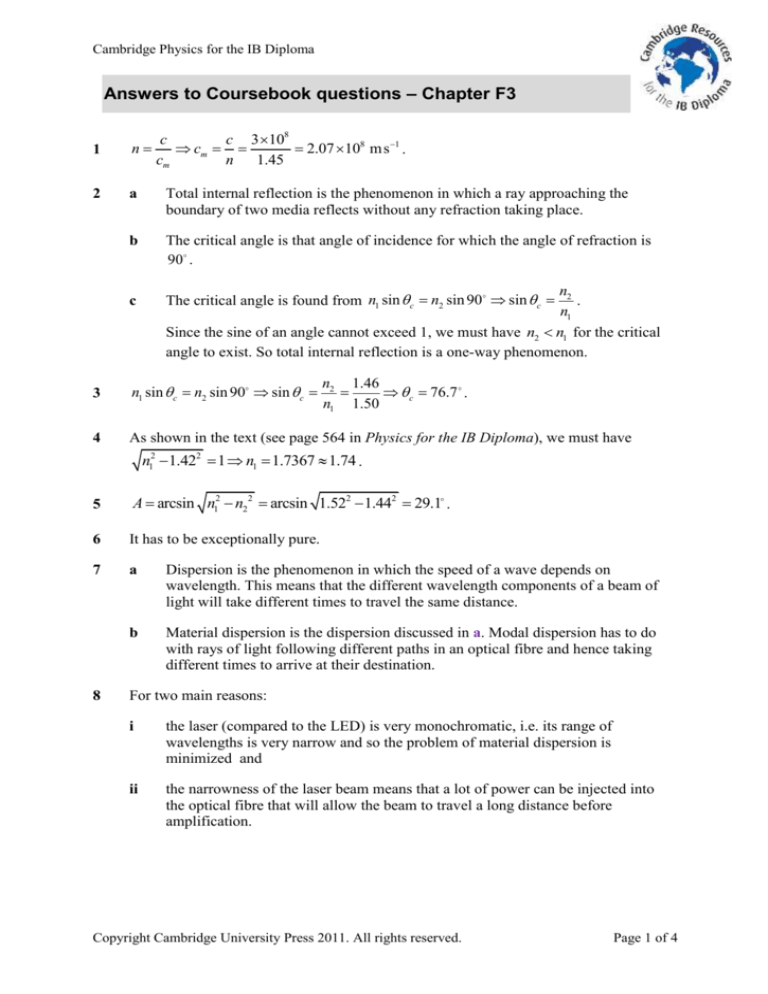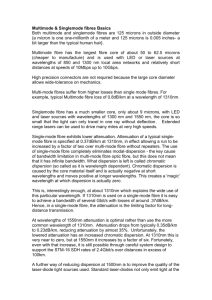
Cambridge Physics for the IB Diploma
Answers to Coursebook questions – Chapter F3
c
c 3 108
cm
2.07 108 ms 1 .
cm
n 1.45
1
n
2
a
Total internal reflection is the phenomenon in which a ray approaching the
boundary of two media reflects without any refraction taking place.
b
The critical angle is that angle of incidence for which the angle of refraction is
90 .
c
The critical angle is found from n1 sin c n2 sin 90 sin c
n2
.
n1
Since the sine of an angle cannot exceed 1, we must have n2 n1 for the critical
angle to exist. So total internal reflection is a one-way phenomenon.
n2 1.46
c 76.7 .
n1 1.50
3
n1 sin c n2 sin 90 sin c
4
As shown in the text (see page 564 in Physics for the IB Diploma), we must have
n12 1.422 1 n1 1.7367 1.74 .
5
A arcsin n12 n22 arcsin 1.522 1.442 29.1 .
6
It has to be exceptionally pure.
7
a
Dispersion is the phenomenon in which the speed of a wave depends on
wavelength. This means that the different wavelength components of a beam of
light will take different times to travel the same distance.
b
Material dispersion is the dispersion discussed in a. Modal dispersion has to do
with rays of light following different paths in an optical fibre and hence taking
different times to arrive at their destination.
8
For two main reasons:
i
the laser (compared to the LED) is very monochromatic, i.e. its range of
wavelengths is very narrow and so the problem of material dispersion is
minimized and
ii
the narrowness of the laser beam means that a lot of power can be injected into
the optical fibre that will allow the beam to travel a long distance before
amplification.
Copyright Cambridge University Press 2011. All rights reserved.
Page 1 of 4
Cambridge Physics for the IB Diploma
9
c
c 3 108
cm
1.9737 108 1.97 108 ms 1 .
cm
n 1.52
a
n
b
The shortest time will be for a ray that travels down the length of the fibre on a
straight line of length 8.0 km, i.e. the time of travel will be
8.0 103
4.05 105 s .
8
1.9737 10
The longest time of travel will be for that ray that undergoes as many internal
reflections as possible.
8.0
The length of the path travelled is then
8.0786 8.08 km (see diagram)
sin 82
8.0786 103
and so the time is
4.09 105 s .
1.9737 108
82
x = y/sin82
y
10
The height of the pulses will be less and the width of the pulses greater.
11
a
A monomode optical fibre is a fibre with a very thin core, so that effectively all
rays entering the fibre follow the same path.
In a multimode fibre (which is thicker than a monomode fibre), rays follow very
many paths of different length in getting to their destination.
b
The transition from multimode to monomode fibres offers a very large increase in
bandwidth. As discussed also in Q13, dispersion limits the maximum frequency
that can be transmitted and hence the bandwidth. A very small diameter
monomode fibre will suffer the least from modal dispersion (and hence the
distortion and widening of the pulse), and material dispersion is also minimized
by using lasers rather than LEDs. Hence the bandwidth is increased as the
monomode fibre diameter is decreased and laser light is used.
12
Advantages include:
i
the low attenuation per unit length, which means that a signal can travel large
distances before amplification,
ii
increased security because the signal can be encrypted and the transmission line
itself cannot easily be tampered with,
iii
large bandwidth and so a large information carrying capacity,
iv
not susceptible to noise,
Copyright Cambridge University Press 2011. All rights reserved.
Page 2 of 4
Cambridge Physics for the IB Diploma
13
v
they are thin and light, and
vi
do not radiate, so there is no crosstalk between lines that are close to each
other.
Dispersion means that different wavelengths (frequencies) travel at different speeds
(material dispersion). And waves travelling along different paths take different times to
arrive (modal dispersion). Either way, this has the effect of distorting a pulse after
travelling a certain distance in a medium.
a
A square pulse, for example, will become wider. This is because the wavelengths
travelling faster will ‘move ahead’ and the slow ones will be ‘left behind’. Thus
the pulse is wider and so its duration will increase. The bit rate is the inverse of
the bit duration, and this implies that the bit rate will decrease as a result of
dispersion.
b
Another problem of dispersion is that the fast components in one pulse will catch
up with the slow components in another pulse. This means that the pulses will
start to overlap. Therefore dispersion places a limit on the maximum frequency
that can be transmitted.
14
The main cause of attenuation in an optical fibre is impurities in the glass making up
the core of the fibre.
15
It means that the power of the signal and the power of the noise are related by
P
P
30 10log signal . This implies that signal 103 .
Pnoise
Pnoise
16
It will be the same because the amplifier will amplify both the signal and the noise.
G
Psignal 1010 and
Explicitly, the new power after amplification will be Psignal
G
Pnoise 1010 , where G is the amplifier gain. Then the new signal to noise ratio is
Pnoise
G
P
P 1010
P
10log signal 10log signal
10log signal , i.e. equal to the old ratio, 10 dB.
G
Pnoise
Pnoise
Pnoise 1010
17
Let Pin be the power in to the first amplifier.
G1
Then the power out of the first amplifier is P Pin 10 10 .
This is input to the second amplifier, so its output is
G1
G2
G1 G2
G1 G2
Pout Pin 1010 10 10 Pin 1010 10 Pin 10 10 ,
showing that the gain overall is G1 G2 .
18
The power loss is 10 log
Pout
3.20
10 log
1.58 dB .
Pin
4.60
Copyright Cambridge University Press 2011. All rights reserved.
Page 3 of 4
Cambridge Physics for the IB Diploma
Pout
5.10
10 log
2.167 dB .
Pin
8.40
2.167
So the loss per km is
0.087 dB km 1 .
25
19
The power loss is 10 log
20
The power loss when the power falls to 70% of the original input power is
P
0.70 P
10 log out 10 log
1.55 dB . So, 12 L 1.55 L 0.13 km .
Pin
P
21
There is no overall gain in power since 15 12 3.0 dB . Let the input power be P.
G
10
Then the output power is P P 10 P 100.3 2.0 P .
22
There is no overall gain or loss in power since 7 10 3 0 dB . So the output power
is the same as the input power; the ratio is 1.
23
The overall gain is 10 log
24
20 10 log
Pout
2P
10 log
10 log 2 3.0 dB .
Pin
P
Hence 12 G 6.0 3.0 dB giving G 21 dB .
So, log
25
26
Psignal
Pnoise
Psignal
45
10 log
2.0
Psignal
45
Psignal
45
.
102 100 , giving Psignal 100 45 4.5 W .
a
See the graph on on page 569 in Physics for the IB Diploma.
b
The attenuation per unit length is least for long wavelengths, in particular
1310 nm and 1550 nm, and these are infrared wavelengths.
a
Noise is unwanted power from unwanted signals.
b
i
The main source of noise in a copper wire is the radiation it picks up from
nearby wires and other sources of electromagnetic radiation as well as the
radiation produced by the accelerated motion of the electrons as they move
through the cable itself.
ii
The main source of noise in an optical fibre is the dark current in the
photodiode that is used to record the arrival of a signal at the end of the
fibre.
i
Noise in a copper cable can be reduced by reducing its temperature and
isolating it as far as possible from other sources of electromagnetic
radiation.
ii
Noise in an optical fibre can only be reduced by protecting the photodiode
from other sources of light and using good quality electronics in the
semiconductors of the photodiode junctions.
c
Copyright Cambridge University Press 2011. All rights reserved.
Page 4 of 4








